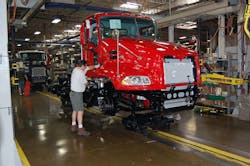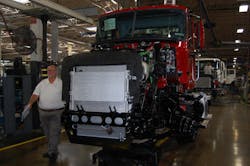A deep decline in Class 8 orders for the month of July is not surprising trucking industry analysts all that much, as both freight demand and rates remain subdued.
North American Class 8 orders slumped to 10,500 units in July, according to data tracked by ACT Research, down 19% from June, down 57% year-over-year, and marking the lowest order level since the first quarter of 2010.
Orders for medium duty trucks – Class 5 through 7 – also declined in July, noted ACT, but not by as much as in the Class 8 segment. Class 5-7 orders dipped down to 14,500 units, according to the firm’s data; down 4% from June and 6% year-over-year.
“In line with the two-speed U.S. economy of healthy consumers and weak industrial activity, the two-speed commercial vehicle story continued to unfold in July,” said Kenny Vieth, ACT’s president & senior analyst, in a statement.
Medium duty orders remained “on trend” in Veith’s view, while Class 8 orders continued to soften, with some of that “softness” related to seasonality as the July-September stretch marks what he called the traditional “low ebb” for Classes 5-8 vehicle orders.
Research firm FTR noted that its data indicated net Class 8 order volume for July dipped to 10,400 units, 56% below the same month in 2015 and the weakest month since February 2010 – dropping “annualized” Class 8 order volume to 210,000 units for the year.
“Usually there are a low number of cancellations in July, but not this year,” said Don Ake, FTR’s vice president of commercial vehicles, in a statement. “The high cancellations are likely the result of fleets placing large orders at the end of 2015, for delivery a year out.”He added that without the cancellations, July orders would have been similar to June’s numbers. But with those cancelations included, month-to-month order volume dipped 19%.
“Freight growth remains sluggish, so fleets are backing off expanding the number of truck,” Ake pointed out. “They are expected to continue to replace older units in the short-term, however. Orders should increase some in August.”
Michael Baudendistel, vice president of the Stifel Transportation & Logistics Research Group, noted that July’s Class 8 order volume is “about as bad as we expected” given that July again is a seasonally weak month for truck orders, with the market giving no reason to believe orders as trucking conditions remain poor or continue to deteriorate.
On the medium-duty side, Baudendistel said Stifel is now lowering its production forecast due to a string of sluggish order months,
“Given three consecutive year-over-year declines in orders and some creep up in inventory levels, we are lowering our outlook for medium duty production [for] 2016 slightly to reflect flat production, down from our prior estimate of a low-single digit increase,” he said.
In terms of expected annual Class 8 production levels down the road, Stifel is projecting a total of 230,000 Class 8 units for this year, down 29% from 2015, falling further in 2017 to 205,000 units (down 11% from 2016), before reaching 200,000 units in 2018 (down 2% from 2017’s estimates).
ACT, however, offers a more robust Class 8 production picture – especially for 2018 – with projections of about 236,000 units this year and 214,000 units in 2017, before a big spike back to 261,000 units in 2018.
About the Author
Sean Kilcarr
Editor in Chief
Sean Kilcarr is a former longtime FleetOwner senior editor who wrote for the publication from 2000 to 2018. He served as editor-in-chief from 2017 to 2018.

